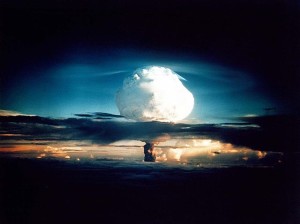
NY Times misses hot news angle?
After reading a July 24, 2009 New York Times article entitled “Radioactive Drug for Tests Is in Short Supply,” by Matthew L. Wald, I could feel my heart start to beat faster and not for any good reason (like when Denise Anne walks into the room). You see “The Gray Lady,” as the typically staid in appearance newspaper is called, missed a hot angle to an otherwise informative article which begins with this:
A global shortage of a radioactive drug crucial to tests for cardiac disease, cancer and kidney function in children is emerging because two aging nuclear reactors that provide most of the world’s supply are shut for repairs.
The 51-year-old reactor in Ontario, Canada, that produces most of this drug, a radioisotope, has been shut since May 14 because of safety problems, and it will stay shut through the end of the year, at least.
Some experts fear it will never reopen. The isotope, technetium-99m, is used in more than 40,000 medical procedures a day in the United States.
Loss of the Ontario reactor created a shortage over the last few weeks. But last Saturday a Dutch reactor that is the other major supplier also closed for a month.
Okay, this reads like the important news story it is. Yet it was the following 40 word-passage, out of this 1,141-word article, about where this technetium-99m is produced that got our attention:
But the preferred material is a high-purity uranium-235, which is also bomb fuel.
Mr. Markey and others are trying to have the industry switch to low-enriched — nonweapons-grade — uranium.
Dr. Crowley said that could be done, although the industry has resisted.
Say what? The amount of bomb grade fuel that ends up as the byproduct of producing this drug for cardiac testing, technetium-99m, and the multitude of poorly-secured places it is stored around the globe, is enough to cause a heart attack. Terrorists would love to get their hands on the stuff not to just necessarily build an H-Bomb but to create a “dirty bomb” of uranium-235.
This is how it works: you bombard a specialized beam at uranium-235 in a reactor to create technetium-99m but, in the process, you’re left with most of the original uranium-235 intact. Why would that be a problem?
“The United States each year sends 20 kilograms of weapon-grade uranium to a reactor at Chalk River, Ontario, where it is used to create much of the U.S. supply of technetium,” wrote Chris Schneidmiller in an article called “Using Highly Enriched Uranium to Make Medical Products Poses Double Risk, Experts Warn,” from late last year. “The problem is that the waste produced through this work retains 95 percent of the original highly enriched uranium, creating the danger that it could be put to bad uses in the wrong hands.”
And those wrong hands have plenty of places to try to get a hold of this dangerous weapons-grade uranium. Civilian sites around the world contain around 50 metric tons of the stuff and generally have lower levels of security than military sites.
That’s sure makes my heart pitter patter a little faster and not in that good Denise Anne kind of way.
In an October 6, 2008 California Medical Association resolution entitled “Highly Enriched Uranium in Radiopharmaceutical Production,” the CMA noted that “more than 95% of the world’s major medical isotope, technetium-99m (used in 80% of nuclear-medicine procedures worldwide, and derived from molybdenum-99), is sourced from reactors that use HEU neutron targets or HEU reactor fuel, with production using up only 3% of the available uranium-235, with the rest of the un-recycled bomb-grade material, enough for many bombs the size of that dropped over Hiroshima, stockpiled in several poorly secured commercial locations.”
CMA then prevailed “on radiopharmaceutical suppliers to expedite universal conversion of isotope production targets and reactor fuel from highly-enriched uranium (HEU) to low-enriched uranium (LEU) as soon as possible, and to refrain from developing new isotope production facilities that use HEU” and that “this be referred for national action.”
It is beyond me how the New York Times could short-shrift this weapons-grade uranium hot news angle. The article practically presented a nuclear physics lesson in how this cardiac drug is produced but glanced over the fact that in order to make the stuff, the whole world is put further at risk because of potential weaponized use of the byproduct.
Sure, we need that technetium-99m to test heart function, but do we really need to continue to produce, as a byproduct, tons of H-Bomb material because, as The Gray Lady put it, “the industry has resisted” using lower-grade uranium to get the very same isotope?
The New York Times bombed on this one.












Recent Comments